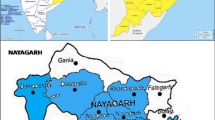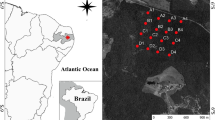Abstract
This study investigated the fleshy fruit characteristics of 28 woody species in a Japanese temperate forest where large sedentary seed-dispersing mammals are present. We tested whether the findings in previous studies in temperate forests of Europe and North America are universal or not. Results have suggested that fruits of all species were eaten both by birds and mammals except for four species with larger fruits, which were eaten only by mammals. A gradient was found from a syndrome characterized by small, oily, and large-seeded fruits to a syndrome characterized by large, succulent, non-oily, and small-seeded fruits. The sizes and colors of the fruits were not conspicuously different from previous findings in Europe and North America. On the other hand, nitrogen and lipids in the fleshy part did not show seasonally increasing trends, or even seasonally decreasing trends in terms of dry weight. This result, suggesting the absence of community-level adaptation of fruit traits to migratory bird dispersers, contrasted with findings in Europe and North America. Large sedentary arboreal or tree-climbing mammals may have a greater effect on the evolution of fruit-disperser relations than opportunistic migratory birds.






Similar content being viewed by others
References
Cipollini ML, Levey DJ (1997) Why are some fruits toxic? Glycoalkaloids in Solanum and fruit choice by vertebrates. Ecology 78:782–798
Corlett R (1996) Characteristics of vertebrate-dispersed fruits in Hong Kong. J Trop Ecol 12:819–833
Corlett RT (1998) Frugivory and seed dispersal by vertebrates in the oriental (Indomalayan) region. Biol Rev 73:413–448
Debussche M, Cortez J, Rimbault I (1987) Variation in fleshy fruit composition in the Mediterranean region: the importance of ripening season, life-form, fruit type and geographical distribution. Oikos 49:244–252
Dennis AJ, Westcott DA (2007) Estimating dispersal kernels produced by a diverse community of vertebrates. In: Dennis AJ, Schupp EW, Green RJ, Westcott DA (eds) Seed dispersal: theory and its application in a changing world. CAB International, Wallingford, pp 201–228
Eriksson O, Ehrlén J (1998) Phenological adaptations in fleshy vertebrate-dispersed fruits of temperate plants. Oikos 82:617–621
Fedriani JP, Delibes M (2009) Seed dispersal in the Iberian pear, Pyrus bourgaeana: a role for infrequent mutualists. Ecoscience 16:311–321
Fukui AW (1995) The role of brown-eared bulbuls as a seed dispersal agent. Popul Ecol 37:211–218
Greig-Smith PW, Wilson MF (1985) Influences of seed size, nutrient composition and phenolic content on the preferences of bullfinches feeding in ash trees. Oikos 44:47–54
Harvey PH, Pagel MD (1991) The comparative method in evolutionary biology. Oxford University Press, Oxford
Hernández Á (2009) Birds and guelder rose Viburnum opulus: selective comsumption and dispersal via regurgitation of small-sized fruits and seeds. Plant Ecol 203:111–122
Herrera CM (1982) Seasonal variation in the quality of fruits and diffuse coevolution between plants and avian dispersers. Ecology 63:773–785
Herrera CM (1987) Vertebrate-dispersed plants of the Iberian Peninsula: a study of fruit characteristics. Ecol Monogr 57:305–331
Herrera CM (1989) Frugivory and seed dispersal by carnivorous mammals, and associated fruit characteristics, in undisturbed Mediterranean habitats. Oikos 55:250–262
Herrera CM, Pellmyr O (2002) Plant-animal interactions: an evolutionary approach. Blackwell Publishing, Malden
Ikeda S (1952) Investigation on the relation of wild birds to industry in Japan. Ornithol Mammal Report 13. Bureau of Agriculture and Forestry, Tokyo (in Japanese with English summary)
Izawa K (2004) The list of food resource of Macaca fuscata in Kinkazan island. Macaca fuscata in Miyagi 18:1–16 (in Japanese)
Izhaki I, Safriel UN (1985) Why do fleshy-fruit plants of the Mediterranean scrub intercept fall-but not spring-passage of seed-dispersing migratory birds? Oecologia 67:40–43
Johnson RA, Willson MF, Thompson JN, Bertin RI (1985) Nutritional values of wild fruits and consumption by migrant frugivorous birds. Ecology 66:819–827
Jordano P (1982) Migrant birds are the main seed dispersers of blackberries in southern Spain. Oikos 38:183–193
Jordano P (1995) Angiosperm fleshy fruits and seed dispersers: a comparative analysis of adaptation and constraints in plant-animal interactions. Am Nat 145:163–191
Jordano P, Garcia C, Godoy JA, Garcia-Castaño JL (2007) Differential contribution of frugivores to complex seed dispersal patterns. P Natl Acad Sci USA 104:3278–3282
Kanouchi T (2006) Handbook of birds and fruits. Bun-ichi, Tokyo (in Japanese)
Kiyosu Y (1966) Encyclopedia of wild birds in Japan. Tokyodo Publishing, Tokyo (in Japanese)
Koike S (2009) Fruiting phenology and its effect on fruit feeding behavior of Asiatic black bears. Mammal Study 34:47–52
Koike S, Masaki T (2008) Frugivory of carnivora in central and southern parts of Japan analyzed by literature search. J Jpn For Soc 90:26–35 (in Japanese with English summary)
Koike S, Kasai S, Yamazaki K, Furubayashi K (2008) Fruit phenology of Prunus jamasakura and the feeding habit of Asiatic black bear as a seed disperser. Ecol Res 23:385–392
Koike S, Masaki T, Nemoto Y, Kozakai C, Yamazaki K, Kasai S, Nakajima A, Kaji K (2010) Estimate of the seed shadow created by the Asiatic black bear (Ursus thibetanus) and its characteristics as a seed disperser in Japanese cool-temperate forest. Oikos 120:280–290
Kominami Y, Sato T, Takeshita K, Manabe T, Endo A, Noma N (2003) Classification of bird-dispersed plants by fruiting phenology, fruit size, and growth form in a primary lucidophyllous forest: an analysis, with implications for the conservation of fruit-bird interactions. Ornithol Sci 2:3–23
Kozakai C, Yamazaki K, Nemoto Y, Nakajima A, Koike S, Abe S, Masaki T, Kaji K (2011) Effect of mast production on home range use of Japanese black bears. J Wildlife Manag (in press)
Levey DJ (1988) Spatial and temporal variation in Costa Rican fruit and fruit-eating bird abundance. Ecol Monogr 58:251–269
Martins EP (2004) COMPARE, version 4.6b. Computer programs for the statistical analysis of comparative data. Distributed by the author at http://compare.bio.indiana.edu/, Department of Biology, Indiana University, Bloomington IN
Masaki T (2002) Structure and dynamics. In: Nakashizuka T, Matsumoto Y (eds) Diversity and interaction in a temperate forest community, Ogawa Forest Reserve of Japan. Springer, Tokyo, pp 53–65
Masaki T, Suzuki W, Niiyama K, Iida S, Tanaka H, Nakashizuka T (1992) Community structure of a species-rich temperate forest, Ogawa Forest Reserve, central Japan. Vegetatio 98:97–111
Masaki T, Kominami Y, Nakashizuka T (1994) Spatial and seasonal patterns of seed dissemination of Cornus controversa in a temperate forest. Ecology 75:1903–1910
Mito Y (2002) Eating plant list of Macaca fuscata. Asian Paleoprimatology 2:89–113 (In Japanese)
Nakanishi H (1996) Fruit color and fruit size of bird-disseminated plants in Japan. Vegetatio 123:207–218
Naoe S, Sakai S, Sawa A, Masaki T (2011) Seasonal difference in the effects of fragmentation on seed dispersal by birds in Japanese temperate forests. Ecol Res 26:301–309
Noma N, Yumoto T (1997) Fruiting phenology of animal-dispersed plants in response to winter migration of frugivores in a warm temperate forest on Yakushima Island, Japan. Ecol Res 12:119–129
Ohdachi SD, Ishibashi Y, Iwasa MA, Saitoh T (2009) The wild mammals of Japan. Shoukadoh, Kyoto
Ohnishi N, Uno R, Ishibashi Y, Tamate HB, Oi T (2009) The influence of climatic oscillations during the Quaternary Era on the genetic structure of Asian black bears in Japan. Heredity 102:579–589
Oka T, Miura S, Masaki T, Suzuki W, Osumi K, Saitoh S (2004) Relationship between changes in beechnut production and Asiatic black bears in northern Japan. J Wildlife Manag 68:979–986
Otani T (2003) Seed dispersal and predation of fleshy-fruited plants by Japanese macaques in the cool temperate zone of northern Japan. Mammal Study 28:153–156
Otani T, Shibata E (2000) Seed dispersal and predation by Yakushima macaques, Macaca fuscata yakui, in a warm temperate forest of Yakushima Island, southern Japan. Ecol Res 15:133–144
Sasagawa A (1962) Food habits of birds by field observation. Yacho 27:77–79 (in Japanese)
Savolainen V (2000) Phylogenetics of flowering plants based on combined analysis of plastid atpB and rbcL gene sequences. Syst Biol 49:306–362
Schupp EW (1993) Quantity, quality and the effectiveness of seed dispersal by animals. Plant Ecol 107(108):15–29
Science and Technology Agency (2005) Standard tables of food composition in Japan. The fifth revised and enlarged edition. National Printing Bureau, Tokyo (in Japanese)
Shibata M, Tanaka H, Iida S, Abe S, Masaki T, Niiyama K, Nakashizuka T (2002) Synchronized annual seed production by 16 principal tree species in a temperate deciduous forest, Japan. Ecology 83:1727–1742
Stiles EW (1993) The influence of pulp lipids on fruit preference by birds. Vegetatio 107(108):227–235
Takahashi K, Kamitani T (2003) Colonization of fleshy-fruited plants beneath perch plant species that bear fleshy fruit. J For Res–JPN 8:169–177
Takahashi K, Kamitani T (2004) Effect of dispersal capacity on forest plant migration at a landscape scale. J Ecol 92:778–785
Takahashi K, Shiota T, Tamatani H, Koyama M, Washitani I (2008) Seasonal variation in fleshy fruit use and seed dispersal by the Japanese black bear (Ursus thibetanus japonicus). Ecol Res 23:471–478
Thompson JN, Willson MF (1979) Evolution of temperate fruit/bird interactions: phenological strategies. Evolution 33:973–982
Tojo H (2009) Breeding bird community of the Ogawa Forest Reserve, an old-growth deciduous forest in central Japan. Ornithol Sci 8:105–115
Traveset A, Willson MF, Verdú M (2004) Characteristics of fleshy fruits in southeast Alaska: phylogenetic comparison with fruits from Illinois. Ecography 27:41–48
Willson MF (1993) Mammals as seed-dispersal mutualists in North America. Oikos 67:159–176
Yagihashi T (2001) Effects of bird ingestion on seed germination of arboreal plants in Hokkaido, Japan. Res Bull Hokkaido Univ For 58:37–59 (in Japanese with English summary)
Yamashina Y (1941) Investigation on food habits of Japanese birds. Tori 11:1–46 (in Japanese)
Yamaura Y, Ikeno S, Sano M, Okabe K, Ozaki K (2009) Bird responses to broad-leaved forest patch area in a plantation landscape across seasons. Biol Conserv 142:2155–2165
Yoshikawa T, Isagi Y, Kikuzawa K (2009) Relationships between bird-dispersed plants and avian fruit consumers with different feeding strategies in Japan. Ecol Res 24:1301–1311
Acknowledgments
The authors would like to thank Mrs. I. Fushimi and Mrs. M. Hosoi for their critical help measuring fruit dimensions and Dr. K. Yamazaki and Dr. C. Kozakai for their help sampling fruits in the field. We are also very grateful to Dr. R. T. Corlett for the comments on an earlier version of the manuscript, and to the Japan Food Research Laboratories, to which we entrusted the measurements of nutritional properties. This study was supported in part by the Research Institute for Humanity and Nature (Project 2-2: Sustainability and biodiversity assessment on forest utilization options), by the Japan Society for the Promotion of Science (19201048), and by the Pollution Control Research Fund of the Ministry of the Environment of Japan (Project on the Japanese black bears’ mass intrusion into human settlements).
Author information
Authors and Affiliations
Corresponding author
Rights and permissions
About this article
Cite this article
Masaki, T., Takahashi, K., Sawa, A. et al. Fleshy fruit characteristics in a temperate deciduous forest of Japan: how unique are they?. J Plant Res 125, 103–114 (2012). https://doi.org/10.1007/s10265-011-0423-0
Received:
Accepted:
Published:
Issue Date:
DOI: https://doi.org/10.1007/s10265-011-0423-0




